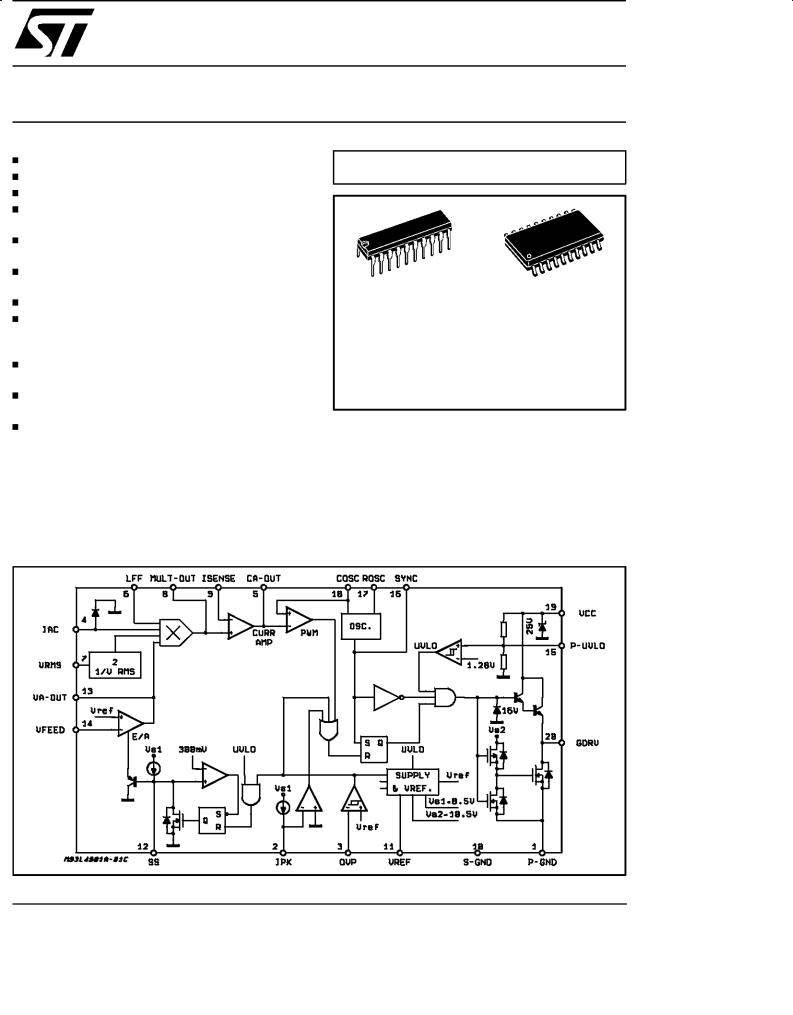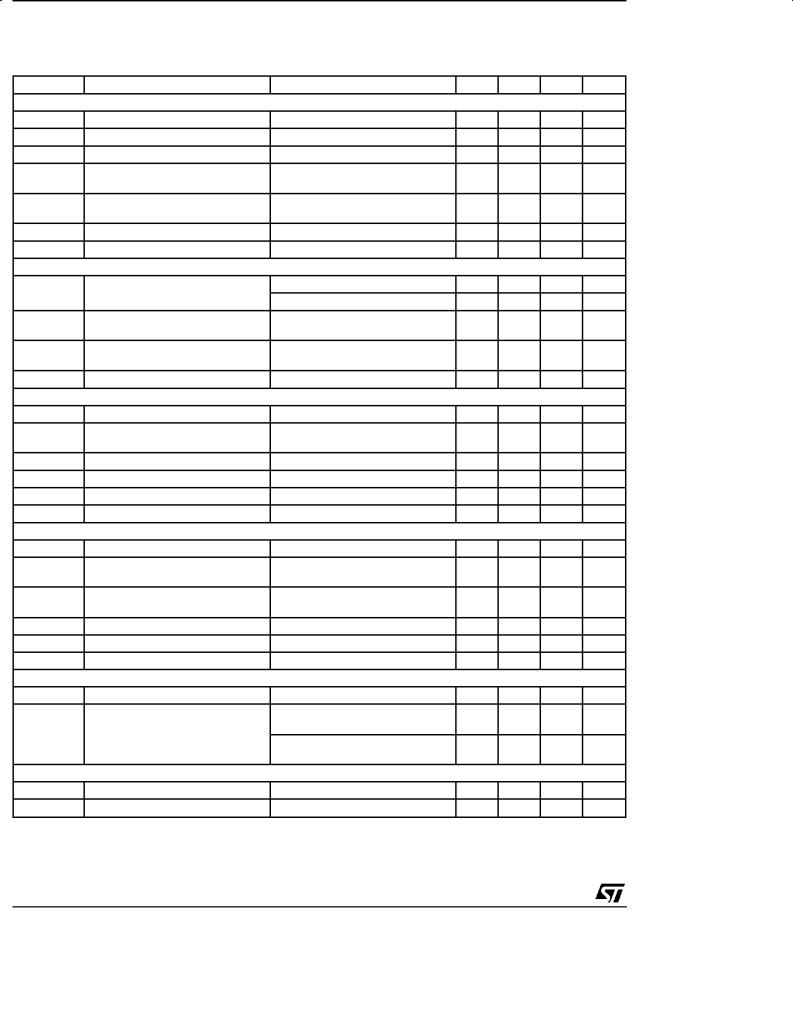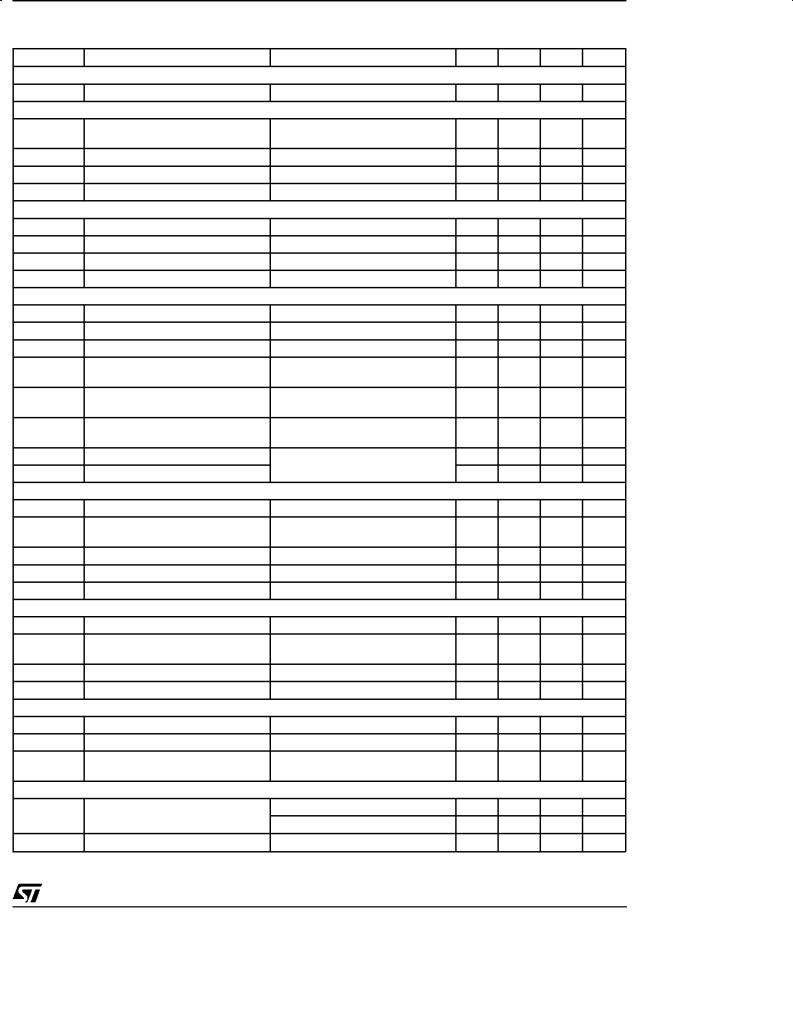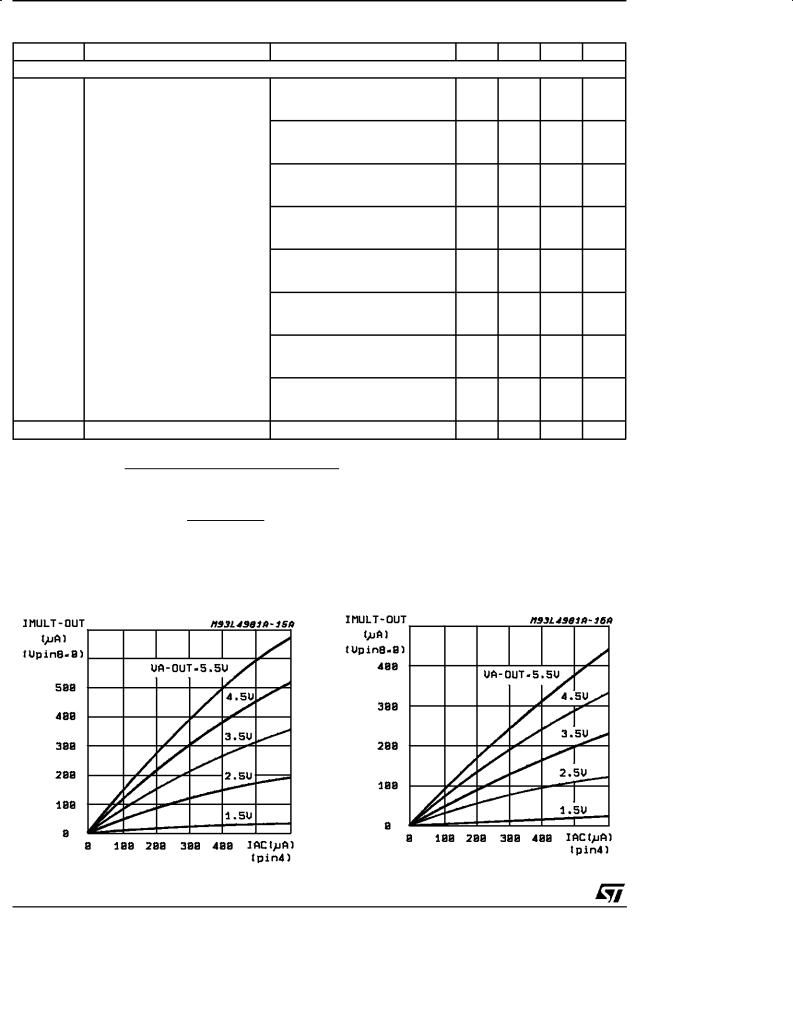SGS Thomson Microelectronics L4981A, L4981BD, L4981B, L4981AD Datasheet

|
L4981A |
|
L4981B |
POWER FACTOR CORRECTOR
CONTROL BOOST PWM UP TO 0.99P.F. LIMIT LINE CURRENT DISTORTION TO < 5% UNIVERSAL INPUT MAINS
FEED FORWARD LINE AND LOAD REGULATION
AVERAGE CURRENT MODE PWM FOR MINIMUM NOISE SENSITIVITY
HIGH CURRENT BIPOLAR AND DMOS TOTEM POLE OUTPUT
LOW START-UP CURRENT (0.3mA TYP.) UNDER VOLTAGE LOCKOUT WITH HYSTERESIS AND PROGRAMMABLE TURN ON THRESHOLD
OVERVOLTAGE, OVERCURRENT PROTECTION
PRECISE 2% ON CHIP REFERENCE EXTERNALLY AVAILABLE
SOFT START
DESCRIPTION
The L4981 I.C. provides the necessary features to achieve a very high power factor up to 0.99. Realized in BCD 60II technology this power factor corrector (PFC) pre-regulator contains all the con-
BLOCK DIAGRAM
MULTIPOWER BCD TECHNOLOGY
DIP20 |
SO20 |
ORDERING NUMBERS: L4981X (DIP20)
L4981XD (SO20)
trol functions for designing a high efficiency-mode power supply with sinusoidal line current consumption.
The L4981 can be easily used in systems with mains voltages between 85V to 265V without any line switch. This new PFC offers the possibility to work at fixed frequency (L4981A) or modulated frequency (L4981B) optimizing the size of the in-
September 1998 |
1/17 |

L4981A - L4981B
put filter; both the operating frequency modes working with an average current mode PWM controller, maintaining sinusoidal line current without slope compensation.
Besides power MOSFET gate driver, precise voltage reference (externally available), error amplifier, undervoltage lockout, current sense and the
ABSOLUTE MAXIMUM RATINGS
soft start are included. To limit the number of the external components, the device integrates protections as overvoltage and overcurrent. The overcurrent level can be programmed using a simple resistor for L4981A. For a better precision and for L4981B an external divider must be used.
Symbol |
Pin |
Parameter |
|
|
Value |
Unit |
VCC |
19 |
Supply Voltage (ICC ≤50mA) (*) |
|
|
selflimit |
V |
IGDRV |
20 |
Gate driv. output peak current (t = 1μs) |
SINK |
2 |
Α |
|
|
. |
|
SOURCE |
1.5 |
A |
|
VGDRV |
|
Gate driv. output voltage t = 0.1μs |
|
|
-1 |
V |
|
|
Voltages at pins 3, 14, 7, 6, 12, 15 |
|
|
-0.3 to 9 |
V |
VVA-OUT |
13 |
Error Amplifier Voltage |
|
|
-0.3 to 8.5 |
V |
IAC |
4 |
AC Input Current |
|
|
5 |
mA |
|
|
Voltages at pin 8, 9 |
|
|
-0.5 to 7 |
V |
VCA-OUT |
5 |
Current Amplifier Volt. (Isource = -20mA; Isink = 20mA) |
-0.3 to 8.5 |
V |
||
VROSC |
17 |
Voltage at pin 17 |
|
|
-0.3 to 3 |
V |
|
11, 18 |
Voltage at pin 11, 18 |
|
|
-0.3 to 7 |
V |
ICOSC |
18 |
Input Sink Current |
|
|
15 |
mA |
IFREQ-MOD |
16 |
Frequency Modulation Sink Current (L4981B) |
|
5 |
mA |
|
VSYNC |
16 |
Sync. Voltage (L4981A) |
|
|
-0.3 to 7 |
V |
VIPK |
2 |
Voltage at pin 2 |
|
|
-0.3 to 5.5 |
V |
|
|
Voltage at Pin 2 t = 1μs |
|
|
-2 |
V |
Ptot |
|
Power Dissipation at Tamb = 70°C |
(DIP20) |
|
1 |
W |
|
|
Power Dissipation at Tamb = 70°C |
(SO20) |
|
0.6 |
W |
Top |
|
Operating Ambient Temperature |
|
|
-40 to 125 |
°C |
Tstg |
|
StorageTemperature |
|
|
-55 to 150 |
°C |
(*) Maximum package power dissipation limits must be observed.
PIN CONNECTIONS (Top views)
L4981A |
L4981B |
|
2/17

L4981A - L4981B
THERMAL DATA
Symbol |
|
Parameter |
DIP 20 |
SO 20 |
Unit |
|
Rth j-amb |
Thermal Resistance Junction-ambient |
80 |
120 |
°C/W |
||
PIN FUNCTIONS |
|
|
|
|
||
N. |
|
Name |
Description |
|
|
|
1 |
|
P-GND |
Power ground. |
|
|
|
2 |
|
IPK |
L4981A peak current limiting. A current limitation is obtained using a single resistor connected |
|||
|
|
|
between Pin 2 and the sense resistor. To have a better precision another resistor between Pin |
|||
|
|
|
2 and a reference voltage (Pin 11) must be added. |
|
|
|
|
|
|
L4981B peak current limiting. A precise current limitation is obtained using two external |
|
||
|
|
|
resistor only. These resistors must be connected between the sense resistor, Pin 2 and the |
|||
|
|
|
reference voltage. |
|
|
|
3 |
|
OVP |
Overvoltage protection. At this input are compared an internal precise 5.1V (typ) voltage |
|
||
|
|
|
reference with a sample of the boost output voltage obtained via a resistive voltage divider in |
|||
|
|
|
order to limit the maximum output peak voltage. |
|
|
|
4 |
|
IAC |
Input for the AC current. An input current proportional to the rectified mains voltage generates, |
|||
|
|
|
via a multiplier, the current reference for the current amplifier. |
|
|
|
5 |
CA-OUT |
Current amplifier output. An external RC network determinates the loop gain. |
|
|||
6 |
|
LFF |
Load feedforward; this voltage input pin allows to modify the multiplier output current |
|
||
|
|
|
proportionally to the load, in order to give a faster response versus load transient. The best |
|||
|
|
|
control is obtained working between 1.5V and 5.3V. If this function is not used, connect this pin |
|||
|
|
|
to the voltage reference (pin = 11). |
|
|
|
7 |
|
VRMS |
Input for proportional RMS line voltage. the VRMS input compesates the line voltage changes. |
|||
|
|
|
Connecting a low pass filter between the rectified line and the pin 7, a DC voltage proportional |
|||
|
|
|
to the input line RMS voltage is obtained. The best control is reached using input voltage |
|
||
|
|
|
between 1.5V and 5.5V. If this function is not used connect this pin to the voltage reference |
|||
|
|
|
(pin = 11). |
|
|
|
8 |
MULT-OUT |
Multiplier output. This pin common to the multiplier output and the current amplifier N.I. input is |
||||
|
|
|
an high impedence input like ISENSE. The MULT-OUT pin must be taken not below -0.5V. |
|
||
9 |
|
ISENSE |
Current amplifier inverting input. Care must be taken to avoid this pin goes down -0.5V. |
|
||
10 |
|
S-GND |
Signal ground. |
|
|
|
11 |
|
VREF |
Output reference voltage (typ = 5.1V).Voltage refence at ± 2% of accuracy externally available, |
|||
|
|
|
it's internally current limited and can deliver an output current up to 10mA. |
|
|
|
12SS A capacitor connected to ground defines the soft start time. An internal current generator delivering 100μA (typ) charges the external capacitor defining the soft start time constant. An internal MOS discharge, the external soft start capacitor both in overvoltage and UVLO conditions.
13 |
VA-OUT |
Error amplifier output, an RC network fixes the voltage loop gain characteristics. |
14 |
VFEED |
Voltage error amplifier inverting input. This feedback input is connected via a voltage divider to |
|
|
the boost output voltage. |
15 |
P-UVLO |
Programmable under voltage lock out threshold input. A voltage divider between supply |
|
|
voltage and GND can be connected in order to program the turn on threshold. |
16 |
SYNC |
This synchronization input/output pin is CMOS logic compatible. Operating as SYNC in, a |
|
(L4981A) |
rectangular wave must be applied at this pin. Opearting as SYNC out, a rectangular clock |
|
|
pulse train is available to synchronize other devices. |
|
FREQ-MOD |
Frequency modulation current input. An external resistor must be connected between pin 16 |
|
(L4981B) |
and the rectified line voltage in order to modulate the oscillator frequency. Connecting pin 16 to |
|
|
ground a fixed frequency imposed by ROSC and COSC is obtained. |
17 |
ROSC |
An external resistor connected to ground fixes the constant charging current of COSC. |
18 |
COSC |
An external capacitor connected to GND fixes the switching frequency. |
19 |
VCC |
Supply input voltage. |
20 |
GDRV |
Output gate driver. Bipolar and DMOS transistors totem pole output stage can deliver peak |
|
|
current in excess 1A useful to drive MOSFET or IGBT power stages. |
3/17

L4981A - L4981B
ELECTRICAL CHARACTERISTICS (Unless otherwise specified VCC = 18V, COSC = 1nF,
ROSC = 24KΩ, CSS = 1μF, VCA-OUT = 3.5V, VISENSE = 0V, VLFF = VREF, IAC = 100μA, VRMS = 1V, VFEED = GND, VIPK = 1V, VOVP = 1V, TJ = 25°C
Symbol |
Prameter |
Test Condition |
Min. |
Typ. |
Max. |
Unit |
|
ERROR AMPLIFIER SECTION |
|
|
|
|
|
|
|
VIO |
Input Offset Voltage |
±25°C < TJ < 85°C |
|
|
±8 |
mV |
|
IIB |
Input Bias Current |
VFEED = 0V |
-500 |
-50 |
500 |
nA |
|
|
Open Loop Gain |
|
|
70 |
100 |
|
dB |
V13H |
Output High voltage |
VFEED = 4.7V |
5.5 |
6.5 |
7.5 |
V |
|
|
|
IVA-OUT = -0.5mA |
|
|
|
|
|
V13L |
Output Low Voltage |
VFEED = 5.5V |
|
0.4 |
1 |
V |
|
|
|
IVA-OUT = 0.5mA |
|
|
|
|
|
-I13 |
Output Source Current |
VFEED = 4.7V; VVA-OUT = 3.5V |
2 |
10 |
|
mA |
|
I13 |
Output Sink Current |
VFEED = 5.5V; VVA-OUT = 3.5V |
4 |
20 |
|
mA |
|
REFERENCE SECTION |
|
|
|
|
|
|
|
Vref |
Reference Output Voltage |
±25°C < TJ < 85°C |
4.97 |
5.1 |
5.23 |
V |
|
|
|
Tj = 25°C |
Iref = 0 |
5.01 |
5.1 |
5.19 |
V |
Vref |
Load Regulation |
1mA ≤ Iref |
≤ 10mA |
|
3 |
15 |
mV |
|
|
±25°C < TJ < 85°C |
|
|
|
|
|
Vref |
Line Regulation |
12V ≤ VCC ≤ 19V |
|
3 |
10 |
mV |
|
|
|
±25°C < TJ < 85°C |
|
|
|
|
|
Iref sc |
Short Circuit Current |
Vref = 0V |
|
20 |
30 |
50 |
mA |
OSCILLATOR SECTION |
|
|
|
|
|
|
|
fosc |
Initial Accuracy |
Tj = 25°C |
|
85 |
100 |
115 |
KHz |
|
Frequency Stability |
12V ≤ VCC ≤ 19V |
80 |
100 |
120 |
KHz |
|
|
|
±25°C < TJ < 85°C |
|
|
|
|
|
Vsvp |
Ramp Valley to Peak |
|
|
4.7 |
5 |
5.3 |
V |
I18C |
Charge Current |
VCOSC = 3.5V |
0.45 |
0.55 |
0.65 |
mA |
|
I18D |
Discharge Current |
VCOSC = 3.5V |
|
11.5 |
|
mA |
|
V18 |
Ramp Valley Voltage |
|
|
0.9 |
1.15 |
1.4 |
V |
SYNC SECTION (Only for L4981A) |
|
|
|
|
|
|
|
tW |
Output Pulse Width |
50% Amplitude |
0.3 |
0.8 |
|
μs |
|
I16 |
Sink Current with Low Output |
VSYNC = 0.4V |
0.4 |
0.8 |
|
mA |
|
|
Voltage |
VCOSC = 0V |
|
|
|
|
|
-I16 |
Source Current with High Output |
VSYNC = 4.5V |
1 |
6 |
|
mA |
|
|
Voltage |
VCOSC = 6.7V |
|
|
|
|
|
V16L |
Low Input Voltage |
|
|
|
|
0.9 |
V |
V16H |
High Input Voltage |
|
|
3.5 |
|
|
V |
td |
Pulse for Synchronization |
|
|
800 |
|
|
ns |
FREQUENCY MODULATION FUNCTION (Only for L4981B)
f18max |
Maximum Oscillation Frequency |
VFREQ-MOD = 0V (Pin 16) Ifreq = 0 |
85 |
100 |
115 |
KHz |
f18min |
Minimum Oscillator Frequency |
IFREQ-MOD = 360μA (Pin 16) |
|
74 |
|
KHz |
|
|
VVRMS = 4V (Pin 7) |
|
|
|
|
|
|
IFREQ-MOD = 180μA (Pin 16) |
|
76 |
|
KHz |
|
|
VVRMS = 2V (Pin 7) |
|
|
|
|
SOFT START SECTION |
|
|
|
|
|
|
ISS |
Soft Start Source Current |
VSS = 3V |
60 |
100 |
140 |
μA |
V12sat |
Output Saturation Voltage |
V3 = 6V, ISS = 2mA |
|
0.1 |
0.25 |
V |
4/17

L4981A - L4981B
ELECTRICAL CHARACTERISTICS (continued)
Symbol |
Parameter |
|
Test Condition |
Min. |
Typ. |
Max. |
Unit |
|
SUPPLY VOLTAGE |
|
|
|
|
|
|
|
|
VCC |
Operating Supply Voltage |
|
|
|
|
|
19.5 |
V |
OVER VOLTAGE PROTECTION COMPARATOR |
|
|
|
|
|
|
||
Vthr |
Rising Threshold Voltage |
|
|
|
Vref |
5.1 |
Vref |
V |
|
|
|
|
|
-20mV |
|
+20mV |
|
V3Hys |
Hysteresis |
|
|
|
180 |
250 |
320 |
mV |
I3 |
Input Bias Current |
|
|
|
|
0.05 |
1 |
μA |
td |
Propagation delay to output |
VOVP = Vthr +100mV |
|
1 |
2 |
μs |
||
OVER CURRENT PROTECTION COMPARATOR |
|
|
|
|
|
|
||
Vth |
Threshold Voltage |
|
|
|
|
|
±30 |
mV |
td |
Propagation delay to Output |
VOCP = Vthr -0.2V |
|
0.4 |
0.9 |
μs |
||
Iipk |
Current Source Generator |
VIPK = -0.1V |
only for L4981A |
65 |
85 |
105 |
μA |
|
IL |
Leakage Current |
VIPK = -0.1V |
only for L4981B |
|
|
5 |
μA |
|
CURRENT AMPLIFIER SECTION |
|
|
|
|
|
|
|
|
Voffset |
Input Offset Voltage |
VMULT OUT = VSENSE = 3.5V |
|
|
±2 |
mV |
||
I9bias |
Input Bias Current |
VSENSE = 0V |
|
-500 |
50 |
500 |
nA |
|
|
Open Loop Gain |
1.1V ≤ |
VCA OUT ≤ 6V |
70 |
100 |
|
dB |
|
SVR |
Supply Voltage Rejection |
12V ≤ |
VCC ≤ 19V |
68 |
90 |
|
dB |
|
|
|
VMULT OUT = 3.5V VSENSE = 3.5V |
|
|
|
|
||
V5H |
Output High Voltage |
VMULT OUT = 200mV |
6.2 |
|
|
V |
||
|
|
ICA OUT = -0.5mA, VIAC = 0V |
|
|
|
|
||
V5L |
Output Low Voltage |
VMULT OUT = -200mV |
|
|
0.9 |
V |
||
|
|
ICA OUT = 0.5mA, VIAC = 0V |
|
|
|
|
||
-I5 |
Output Source Current |
VMULT OUT = 200mV, |
2 |
10 |
|
mA |
||
I5 |
Output Sink Current |
VIAC = 0V, VCA-OUT = 3.5V |
2 |
10 |
|
mA |
||
|
|
|
|
|||||
OUTPUT SECTION |
|
|
|
|
|
|
|
|
V20L |
Output Voltage Low |
ISINK = 250mA |
|
|
0.5 |
0.8 |
V |
|
V20H |
Output Voltage High |
ISOURCE = 250mA |
11.5 |
12.5 |
|
V |
||
|
|
VCC = 15V |
|
|
|
|
|
|
tr |
Output Voltage Rise Time |
COUT = 1nF |
|
|
50 |
150 |
ns |
|
tf |
Output Voltage Fall Time |
COUT = 1nF |
|
|
30 |
100 |
ns |
|
VGDRV |
Voltage Clamp |
ISOURCE = 0mA |
13 |
16 |
19 |
V |
||
TOTAL STANDBY CURRENT SECTION |
|
|
|
|
|
|
|
|
I19start |
Supply Current before start up |
VCC = 14V |
|
|
0.3 |
0.5 |
mA |
|
I19on |
Supply Current after turn on |
VIAC = 0V, VCOSC = 0, |
|
8 |
12 |
mA |
||
|
|
Pin17 = Open |
|
|
|
|
|
|
I19 |
Operating Supply Current |
Pin20 = 1nF |
|
|
12 |
16 |
mA |
|
VCC |
Zener Voltage |
(*) |
|
|
20 |
25 |
30 |
V |
UNDER VOLTAGE LOCKOUT SECTION |
|
|
|
|
|
|
|
|
Vth ON
Vth OFF
Turn on Threshold |
14.5 |
15.5 |
16.5 |
V |
Turn off Threshold |
9 |
10 |
11 |
V |
Programmable Turn-on Threshold Pin 15 to VCC = 220K |
10.6 |
12 |
13.4 |
V |
Pin15 to GND = 33K |
|
|
|
|
LOAD FEED FORWARD |
|
|
|
|
|
ILFF |
Bias Current |
V6 = 1.6V |
70 |
140 |
μA |
|
|
V6 = 5.3V |
200 |
300 |
μA |
VI |
Input Voltage Range |
|
1.6 |
5.3 |
V |
(*) Maximum package power dissipation limits must be observed.
5/17

L4981A - L4981B
ELECTRICAL CHARACTERISTICS (continued)
Symbol |
Prameter |
Test Condition |
Min. |
Typ. |
Max. |
Unit |
MULTIPLIER SECTION |
|
|
|
|
|
|
|
Multipler Output Current |
VVA-OUT = 4V, VRMS = 2V, |
20 |
35 |
52 |
μA |
|
|
VMULTOUT = 0, VLFF = 5.1V |
|
|
|
|
|
|
IAC = 50μA, COSC = 0V |
|
|
|
|
|
|
VVA-OUT = 4V, VRMS = 2V, |
100 |
135 |
170 |
μA |
|
|
VMULTOUT = 0, VLFF = 5.1V |
|
|
|
|
|
|
IAC = 200μA, COSC = 0V |
|
|
|
|
|
|
VVA-OUT = 2V, VRMS = 2V, |
10 |
20 |
30 |
μA |
|
|
VMULTOUT = 0, VLFF = 5.1V |
|
|
|
|
|
|
IAC = 100μA, COSC = 0V |
|
|
|
|
|
|
VVA-OUT = 2V, VRMS = 4V, |
2 |
5.5 |
11 |
μA |
|
|
VMULTOUT = 0, VLFF = 5.1V |
|
|
|
|
|
|
IAC = 100μA, COSC = 0V |
|
|
|
|
|
|
VVA-OUT = 4V, VRMS = 4V, |
10 |
22 |
34 |
μA |
|
|
VMULTOUT = 0, VLFF = 5.1V |
|
|
|
|
|
|
IAC = 100μA, COSC = 0V |
|
|
|
|
|
|
VVA-OUT = 4V, VRMS = 2V, |
20 |
37 |
54 |
μA |
|
|
VMULTOUT = 0, VLFF = 2.5V |
|
|
|
|
|
|
COSC = 0V, IAC = 200μA |
|
|
|
|
|
|
VVA-OUT = 4V, VRMS = 4V |
20 |
39 |
54 |
μA |
|
|
VMULTOUT = 0, VLFF = 5.1V |
|
|
|
|
|
|
IAC = 200μA, COSC = 0V |
|
|
|
|
|
|
VVA-OUT = 2V, VRMS = 4V, |
-2 |
0 |
2 |
μA |
|
|
VMULTOUT = 0, VLFF = 5.1V |
|
|
|
|
|
|
IAC = 0, COSC = 0V |
|
|
|
|
K |
Multiplier Gain |
|
|
0.37 |
|
|
(VVA−OUT − 1.28) (0.8 VLFF − 1.28) |
||||
IMULT−OUT = K IAC |
(VVRMS)2 |
|
|
|
|
|
|
||
(V |
− |
− 1.28) |
|
|
VA OUT |
K1 |
|
||
if VLFF = VREF; IMULT−OUT = IAC |
(VVRMS)2 |
|
||
|
|
|
||
where: K1 = 1V |
|
|
|
|
Figure 1: MULTI-OUT vs. IAC (VRMS = 1.7V; |
Figure 2: MULTI-OUT vs. IAC (VRMS = 2.2V; |
|||
VLFFD = 5.1V) |
|
|
|
VLFFD = 5.1V) |
6/17
